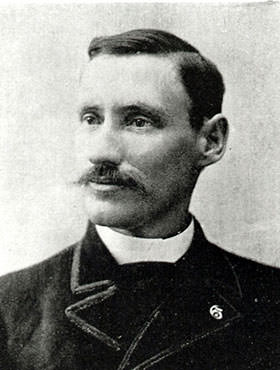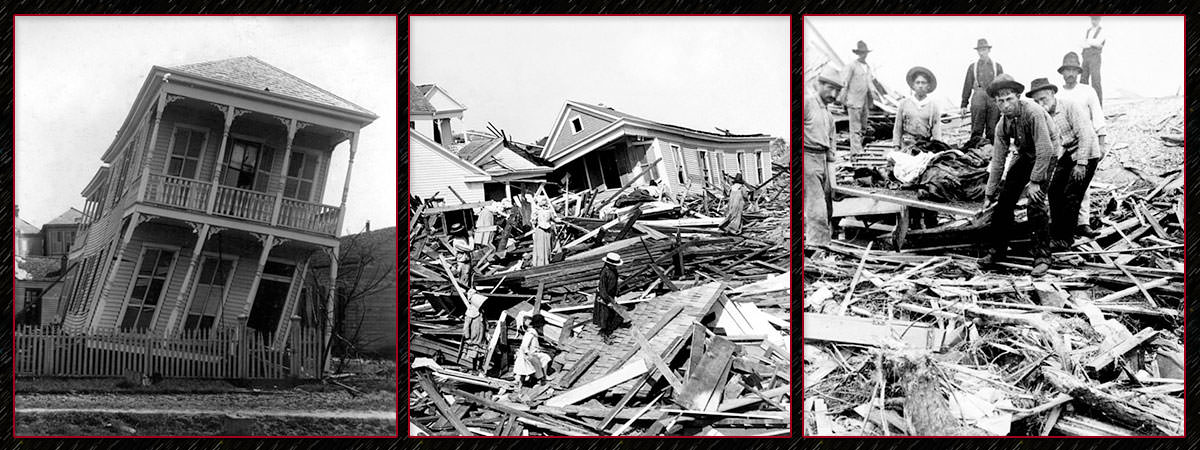On September 8, 1900, the port city of Galveston in the U.S. state of Texas was struck by a Category 4 hurricane which resulted in the deaths of at least 8,000 people. It is the deadliest natural disaster in the history of the United States and the third costliest hurricane ever to strike the nation. Know more about the type, origin, damage caused, death toll and the effect of the 1900 Galveston hurricane, also known as the Great Galveston Hurricane.
#1 GALVESTON WAS THE CHIEF PORT CITY IN TEXAS
Galveston is a coastal city located on Galveston Island in the U.S. state of Texas. It was named in the late 18th century after the Spanish governor of Louisiana, Bernardo de Gálvez. Throughout the 19th century Galveston grew rapidly and became the regions primary business center. By the end of the 19th century, it was the chief port city in Texas and had a population of approximately 40,000.

#2 A SEAWALL TO PROTECT GALVESTON WAS PROPOSED BUT NEVER BUILT
In 1875, Indianola was second to Galveston among Texas port cities. But a couple of hurricanes in 1875 and 1886 forced its residents to move elsewhere. Also Galveston at the time was situated at less than 9 feet above sea level. These factors caused many residents to propose a seawall to be constructed to protect the city. But the chief meteorologist at the Galveston Weather Bureau, Isaac Cline, dismissed these concerns and said that it would be impossible for a hurricane of significant strength to strike the island. This coupled with lack of initiative by the government prevented the construction of a seawall to protect the city.
#3 THE 1900 GALVESTON HURRICANE WAS A CAPE VERDE HURRICANE
The most intense storms of the Atlantic typically start as tropical waves that move off the coast of Africa and pass near the Cape Verde islands. They are known as “Cape Verde hurricanes”, in reference to their origin. The Galveston Hurricane of 1900 is believed to be a Cape Verde hurricane. The average hurricane season has about two Cape Verde hurricanes, which are often the largest and most intense storms of the season. Recent Cape Verde hurricanes include Hurricane Ike in 2008 and Hurricane Dean in 2007.

#4 US WEATHER BUREAU WAS WARNED BY CUBAN METEOROLOGISTS
The Galveston storm was first detected on August 27 in the tropical Atlantic. On September 3, it reached Cuba and dropped heavy rains. The US Weather Bureau ignored reports from Cuban meteorologists as they expected the storm to re-curve to northeast along the US east coast and eventually exit into the Atlantic. However a region of high pressure pushed the storm west into the Gulf of Mexico, where conditions were ideal to strengthen the storm and turn it into a devastating hurricane.

#5 THE GREAT GALVESTON HURRICANE WAS A CATEGORY 4 HURRICANE
Although the citizens were warned of an approaching hurricane few heeded the warning. The hurricane made landfall at Galveston on September 8, 1900 with storm tides of 8 to 15 feet (2.5 to 4.5 metres) and winds at more than 130 miles (210 km) per hour. The Saffir–Simpson hurricane wind scale (SSHWS) is used to classify hurricanes by the intensities of their sustained winds. The lowest classification in the scale is Category 1 with winds of at least 74 mph while the highest is Category 5 with winds exceeding 156 mph. With maximum sustained winds of more than 130 mph, Galveston hurricane was a Category 4 hurricane.

#6 IT WAS THE THIRD COSTLIEST HURRICANE IN U.S. HISTORY
Galveston, with its highest point at only 8.7 feet (2.7 m) above sea level, was devastated by the hurricane. Numerous buildings were utterly demolished by the water and wind. Over 3,600 homes were destroyed. The few buildings which survived, mostly solidly built ones along the Strand District, are today maintained as tourist attractions. With damages of around $104.3 billion (2010 USD), 1900 Galveston hurricane is the third costliest hurricane in U.S. history after 1926 Miami hurricane ($164.8 billion) and Hurricane Katrina ($113.4 billion).

#7 IT IS THE DEADLIEST NATURAL DISASTER IN U.S. HISTORY
Estimates of the deaths caused due to the Galveston hurricane vary between 6,000 and 12,000 with the number cited in official reports being 8,000, around 20% of the island’s population. A further 30,000 were left homeless. With a death toll of 8,000, the Galveston Hurricane of 1900 remains the deadliest natural disaster in U.S. history and the third deadliest Atlantic hurricane after the Great Hurricane of 1780 and 1998’s Hurricane Mitch. It killed more people than all tropical cyclones that have struck the United States since.

#8 NEWS OF GALVESTON’S DESTRUCTION COULDN’T REACH MAINLAND TILL SEPTEMBER 9
Due to destruction of telegraph lines and bridges to the mainland, news of Galveston was not able to reach mainland till six messengers from the city reached Texas City at 11 a.m. on September 9 through Pherabe, one of the few ships to survive the storm. Rescuers arrived to find the city completely destroyed. Survivors set up temporary shelters in surplus U.S. Army tents along the shore. The first post-storm mail reached Galveston on September 12 and by September 13, basic water service was restored. Within three weeks, cotton was again being shipped out of the port.

#9 THE GALVESTON SEAWALL WAS BUILT TO PROTECT THE ISLAND FROM FUTURE HURRICANES
The Galveston Seawall was built after the 1900 hurricane for protection from future hurricanes. To replace the bridges lost to the storm, an all-weather bridge was constructed providing reliable access to mainland. Also Galveston was raised by as much as 17 feet (5.2 m) above its previous elevation. More than 2,100 buildings were raised in the process. Galveston was tested by a 1915 hurricane of similar strength. 53 people lost their lives, a number significantly less than the death toll of the 1900 hurricane. In 2001, the Galveston Seawall and raising of the island were named jointly as a National Historical Civil Engineering Landmark.

#10 POST HURRICANE GALVESTON WAS OVERTAKEN BY HOUSTON AS THE PREMIER SHIPPING PORT
Despite reconstruction and attempts to draw new investment to the city, Galveston never fully returned to its previous level of national importance or prosperity. The city lost its status as the premier shipping port to Houston a few years after the disaster. Today, much of Galveston’s economy is centered on tourism, health care, shipping, and financial industries. Various references to the Great Galveston Hurricane appear in popular culture including the American folk song “Wasn’t That a Mighty Storm”, which was popularized by Eric Von Schmidt and Tom Rush in the 1960s.

THE GALVESTON STORM IN NEW YORK CITY
The Galveston storm reached New York City on September 12, 1900 still exhibiting winds of 65 mph (105 km/h). Trees were uprooted, signs and similar structures were blown down, and yachts were torn from moorings. The canvas roofing at the Fire Department headquarters was blown off. Also pedestrian-walking became difficult. A sign pole broke due to the wind and landed on a 23-year-old man, crushing his skull and killing him instantly. This was the only reported death in New York City due to the storm.


In a book (fiction) that I was recently reading, part of the story depicted the timeline from storm warnings being ignored to the hurricane’s destruction of Galveston. Since I was unaware of this flood, until I read this book I wanted to learn more about the flood. I found the 10 facts interesting and was glad that the writer so accurately described the flood in her book.